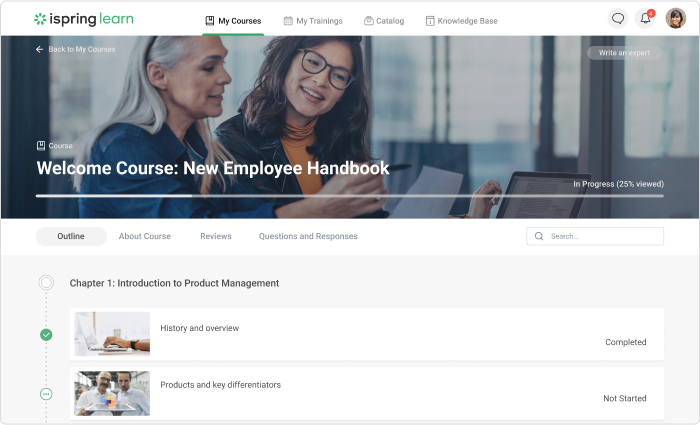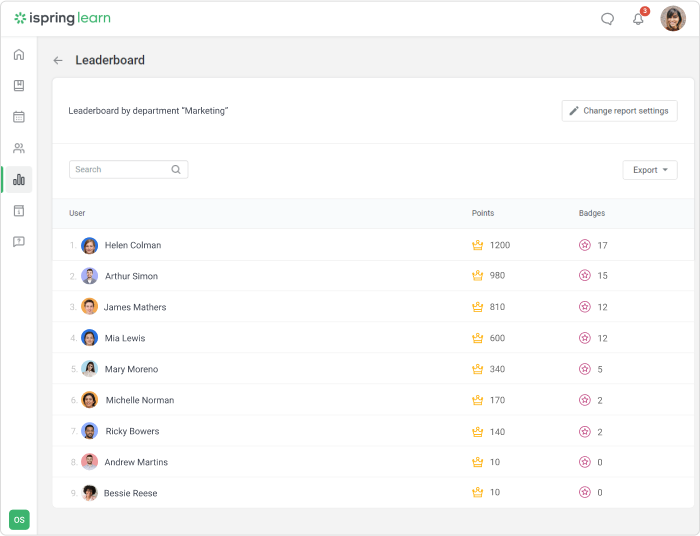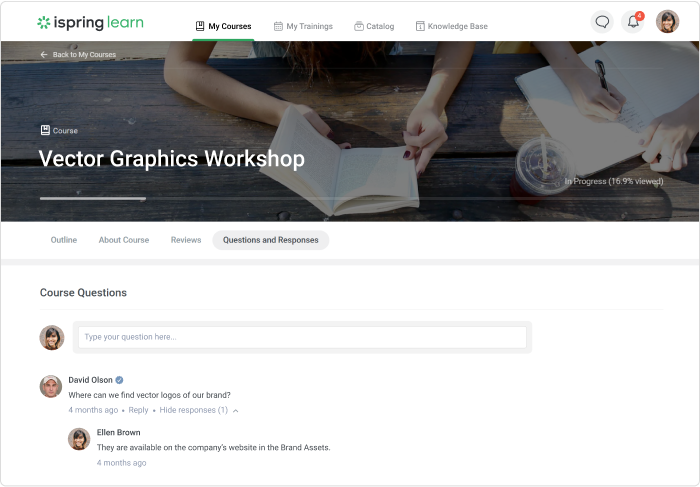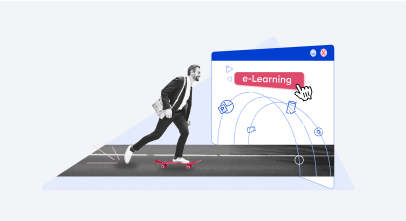10 Barriers to Learning and How to Overcome Them

We’ve all been there: a class in high school or college that bored us to death. We felt disengaged and had a hard time finishing strong. Boredom is a typical barrier to learning. These are the barriers that demotivate people and deprive them of the opportunity to know what they should know.
As education continues post-graduation, barriers to learning don’t go away. They are still there in corporate training or any other type of adult learning.
So it’s important to know how to handle the barriers to learning and achieve better results.
In this article, we’ll explain how to recognize and address learning barriers so that nothing could stop your learners from developing.
You can go through all of them with us, or you can jump right to the common learning barriers that are especially relevant for you.
Motivational learning barriers
What Are Barriers to Learning?
A barrier to learning is anything that prevents a learner from being fully engaged in the learning process. A person, or even a group of people, affected by learning barriers feels frustrated or unwilling, and cannot achieve their learning goals.
Learning barriers can be caused by various factors. Some are purely external: tight schedules, too much work, lack of available materials or technologies, and so forth.
Others are internal and originate in people’s preexisting experiences, emotional factors, or mindsets. Sometimes internal and external factors join forces.
For example, a trainee can feel a fear of failure, due to an unsupportive environment in the company, pressure from the management, or lack of knowledge needed for the task.
For better learner engagement and participation, instructors should eliminate learning barriers as much as possible, and help learners overcome them. Reasons for their emergence may vary, but barriers to learning fall into three basic categories: emotional, motivational, and personal. Let’s look at each one in detail.
Emotional Learning Barriers

These are the barriers that make learners feel deeply uncomfortable, sabotaging the learning process. People experience fear or doubt, and it can seem to them that they are “weak,” “not good enough” to try.
They may rationally understand the necessity of training and recognize its importance to their self-growth or career. But they want to finish the process as soon as possible or never start it at all.
These emotional barriers include resistance to change, fear of failure, and lack of focus.
Resistance to change
Every new endeavor produces some change and makes us step out of our comfort zone. People may feel not ready for this. Take employees who sabotage online learning. Such resistance to change may appear in at least two forms:
- Hesitance toward technologies. People may think that they are not tech geeks, and therefore they are unable to adapt to digitization and staying on top of new trends.
- “I already know it all.” People may presume that there is nothing so new in their industry that they should have to undertake another round of training or a new online course.
Resistance to change is a preexisting belief that may strongly hinder a company’s training and development program.
How to overcome this emotional learning barrier:
Let’s accept the truth: starting something new ain’t easy. If you initiate training in your organization, then it’s important that you recognize this foundational unwillingness to change among employees.
Accept these concerns and respond to them appropriately. Clear, supportive communication is a must.
You should also provide your learners with sufficient information about the training. If, for example, you launch online training with a learning management system (LMS), then you can tell learners that taking courses and quizzes online is no harder than surfing the internet. Record a video tutorial to explain how to use the platform and provide users with all the help docs they’ll need.
You initially need to choose software with a user-friendly, intuitive interface so your team members and learners can use it right away.
Fear of failure
It’s very common for people to think that not trying is safer than risking unknown results. This stops many people from learning valuable skills and taking advantage of wonderful opportunities.
Whether new hires and interns or overachievers and perfectionists, everyone may be afraid of failure and reluctant to practice new knowledge and skills. But knowing that mistakes are inevitable in learning, shouldn’t we be able to relax in the process?
How to overcome this emotional learning barrier:
Allow for mistakes, and use empowering language to help learners develop a positive attitude toward learning.
Encourage them to practice, and explain that making mistakes now in training is much better than not knowing how to act in work and real-life situations. Help them enhance their self-correcting skills so they can learn how to detect their mistakes and fix them right away.
With online training, you can greatly reduce the fear of failure. If you use an authoring tool to create quizzes, you can allow for multiple attempts on the same question. This way, if learners made a mistake once or twice, they still have the opportunity to give the right answer and learn.
It’s a good idea to add encouraging or explanatory automated feedback for each response. Phrases like “Well done!” or “You’re doing great!” or “You’ll nail it next time!” will help learners overcome their fears and keep trying.

For customer service and sales, mistakes in real life can cause reputational risks and cost a lot of money. When the stakes are high, we recall pilots who learn to fly an aircraft using a flight simulator. Their training prepares them for the real flight, recreating its stages and possible situations that might occur. For corporate training, dialogue simulations can function like this virtual simulator, allowing people to practice communication skills and techniques.
Look at this dialogue simulation created with the iSpring Suite authoring toolkit:
Dialogue simulations exemplify the “fake it till you make it” principle and help people learn to behave confidently in various situations. They are role-plays in a risk-free environment, where it’s totally fine to make mistakes. Dialogue simulations train your employees to operate in accordance with established procedures and to minimize errors in work.
Read also: 8 Most Common Role-play Scenarios
Lack of focus
Okay, so we’ve managed to overcome resistance to change and the fear of failure. Learners are ready to study…right? But wait: here comes another tricky barrier to learning. According to the study, employees only have an average of 24 minutes a week for training and development. That’s just 1% of their typical work week. And even during these 24 minutes a week, it’s not always easy for them to focus, because workplaces can be noisy and distracting.
How to overcome this emotional learning barrier:
If your training takes place in an office environment, it’s best to remove distracting factors and make space for silence. It can be a “focus hour” for everyone, a single space in which people can study or just sit calmly, or they can receive intentional guidance on certain tactics, to increase focus and productivity. These measures help foster learning culture company-wide and inculcate a serious attitude toward training.
Smartphones can be very distracting in the classroom and workplace, but if you move learning online and make it available on mobile devices, you can leverage the technology to your advantage.
Mobile-friendly LMSs like iSpring Learn have apps for smartphones and tablets that allow learners to take courses anywhere and anytime they want, even on the go. This gives them more time and space for training, when they find their focus.
Motivational Learning Barriers

So, now that we’ve overcome the first emotional barriers, the next challenge is to proceed with learning. You may notice that suddenly your employees start missing classes or refuse to take courses.
That’s what motivational barriers are all about. They’re the ones that get in the way when the learning process has already started.
Let’s go through the main reasons this happens, and the ways we can deal with it.
Lack of previous knowledge
A child crawls, then walks, then runs. It’s natural that learning comes in stages, and no stage should be omitted. This is true for adults when they train for new skills. If a learner doesn’t know the basics, or changes to a new area of work, or wasn’t ever introduced to the product line, then this will hinder subsequent development.
How to overcome this learning barrier:
Your training course should be consistent, so plan it beforehand. Ensure that it works through the material from the basics to more specific details. With an LMS, you can compile lessons and materials in a track adjusted to a certain department, groups, or individuals. The system will automatically assign the relevant courses to the selected group of learners.
For example, you can create special learning tracks for every new hire, and they will get access to systematic training from day one.

An example of consistent training in product management, in iSpring Learn
You can also use your LMS as the company’s knowledge base. Store helpful information, readings, and links here so your learners can access them any time.
Lack of seeing the big picture
Sometimes employees don’t see the point in training, because they don’t know precisely how the company functions, nor its business and development strategy. They don’t have a clear vision of their position in the company and where everything is headed. The training part just doesn’t seem integrated into their idea of work, and so they have no motivation to do anything about their skills and approaches.
How to overcome this learning barrier:
Think about the sense of community and ensure that everyone feels that they belong, matter, and have a part to play. If you prefer on-the-job learning, choose experienced employees to become mentors for new hires. This will increase the sense of community, both for seasoned staff members and novices.
Clearly articulate your mission, vision, and values, and include this information in your onboarding program. Courses on company culture, history, and achievements equip employees to fit into the team and recognize the value of training for all. Learn more about how to give a new employee a warm welcome in our guide to new hire onboarding.
Lack of purpose
Learners can think of training as purposeless if they see no reason that it will help them in life or work. Here’s the thing about adult learners: they want to know how education or training will change their lives for the better and make daily tasks easier. So your reasons for giving the training won’t be good enough until they address the learners’ practical needs.
How to overcome this learning barrier:
Work with the practical side of things and explain to learners the results they can expect from training. Or, address their pain points and show the concrete solution provided by your training.
A tip: you can start with new titles for your courses. Compare these titles:
- “Time management” vs. “How to Maximize Your Efficiency and Avoid Working Overtime”
- “Strategic thinking” vs. “How to Set Your Priorities and Plan Needed Actions”
Do you see the difference? Being upfront about the goals and outcomes of training will save you time in explaining why the training is worthwhile. And of course you should fill your courses and training materials with practical tips, solutions, and exercises so that learners know how to apply the knowledge in real life.
Here’s an example of a practical course with clearly established goals and hands-on practices:
Boredom
Let’s admit it: some training topics are not meant to be fun for learners. But they are necessary, important for business, and, like various compliance courses, tend to be obligatory.
But a topic’s seriousness is no excuse for sloppy, unreadable slides that instantly make everyone bored and inattentive. Boredom is the main foe of learners’ engagement and can be a strong barrier even for avid learners.
How to overcome this learning barrier:
If you conduct training offline, make sure your learners interact with their peers and with you. Work in pairs or teams, organize Q&A sessions, give them handouts with quick exercises, and take breaks to recharge their brains. If you use slides to support your presentation, make them less wordy—use more media.
For a virtual classroom, prepare rich content that includes videos, screencasts, images, infographics, animations, and sounds. Use a whiteboard feature to work out some ideas visually.
Design warm-up and closure activities to engage learners and enhance knowledge retention. (The “raise hand” feature can be helpful.)
When building online courses, you should involve interactivity. For example, create interactive quizzes and game-like activities, such as drag-and-drops. With iSpring Suite authoring software, you can easily make them from templates and then embed them into a background, like an office, a hospital, or a supermarket. You can prompt learners to interact with a variety of objects, icons, and characters. Creating all of this doesn’t take a lot of effort, but it will make the training experience much more fun, engaging, and credible.

An exercise from the online course on merchandising
Isolation
This barrier has become particularly severe because of the pandemic. Many people have experienced social isolation and loneliness, and this can have a big effect on motivation. When people feel lonely, it’s harder for them to set and achieve goals. Some people like feeling that we’re all in the same boat, with peers going through the same hurdles. Some people need a sense of competition. Some want to have an instructor nearby, to be sure that they’re doing everything right. If any of those desires is not addressed, some learners may fall behind in training.
How to overcome this learning barrier:
As with the lack of seeing the big picture, you also need to enhance the sense of community and check in on learners. Depending on the training and its goals, you can assign employees new mentors, or create a system of leaderboards that will display the best learners of the month.
In iSpring Learn LMS, you can easily set leaderboards easily and the platform will automatically compile them. Based on the points employees earn after completing a course, iSpring Learn lists the best learners and compiles leaderboards. This simple gamification trick is a good way to motivate employees to take courses and see how their peers are doing.

To maintain a sense of community, allow your learners to communicate with one another, chat, and interact. This is also possible within an LMS. Let them ask authors questions about a particular course, leave reviews, and share their insights in the comment section.
They also can reach out to colleagues from various departments through direct messages and ask questions for clarification. This is particularly helpful when the course is important to the work of several departments that need to synchronize.

Personal Learning Barriers

These barriers to learning are closely related to a person’s particular traits and characteristics.
The way a person perceives information determines limitations and specific needs. In order to effectively address each person, we should adjust the learning content to improve comprehension. Every obstacle is an opportunity; personal barriers prompt us to embrace diversity and make learning available and accessible for everyone.
Let’s look at probable personal (but completely solvable) barriers to learning: different learning styles and impairments.
Different learning styles
It may seem that reading written texts or listening to oral lectures are the universal ways to learn and distribute new information. But they can be insufficient. To really engage learners, the learning content sometimes needs to become more visual or tangible. Though the presumed dominance of visual, kinesthetic, or auditory perceptions can be questioned, even for just one person, all learners certainly have preferences and difficulties.
For example, some people are not good with numbers and can’t stand tables with figures. Some people can easily spot the difference in pictures, and others can’t. Some memorize sounds better than graphics. And the list goes on. So if the instructor exploits only one of the ways to communicate information, not all of the learners will be able to follow.
How to overcome this learning barrier:
Bring diversity to the ways you communicate the information and interact with the learners. Mix things up with various formats. Using the authoring software like iSpring Suite, you can accompany instructions with screencasts, courses with videos, and quizzes with audio, all with one single tool. Such diverse, interactive learning content will make your training appealing to the widest audience.
Impairments
Last but not least are the health conditions that can make the learning process more challenging or uncomfortable for some learners. Such conditions may include hearing, visual, or learning impairments, and they demand adjustments to the content, to meet the standards and principles, like WCAG or Section 508.
How to overcome this learning barrier:
When you finish creating a course, your top priority is to ensure that it is fully accessible to all learners. Follow these steps:
- Write step-by-step instructions in plain language.
- Provide subtitles and captions to all videos.
- Keep all other texts concise, clear, and well-structured.
- Make all images well-contrasted, and add alt-texts.
- Make a final check of accessibility.
If you use iSpring Suite to create online courses, don’t hesitate to use its Accessibility mode. It allows the automatic aligning of learning material with WCAG requirements without creating a different version of the course from scratch. While taking the course, learners can switch to the Accessibility mode with just a click when needed, and then see the information in the most comfortable way.
FAQs on Barriers to Learning
1. What are intrinsic and extrinsic barriers to learning?
Intrinsic barriers are the personal attitudes, beliefs, and health conditions that hinder a person’s participation in the learning process or that negatively affect its results. Examples of intrinsic barriers to learning include lack of interest or motivation, low self-confidence, limited attention span, learning disabilities, and difficulty in understanding new concepts. These barriers can significantly impact a person’s ability to acquire and retain new knowledge.
Extrinsic barriers to learning refer to external factors that hinder a person’s ability to learn. These can include limited access to resources, lack of support from teachers or peers, and environmental factors such as noise or distractions.
2. How to identify barriers to learning?
Look for signs in the learners’ behavior—such as resistance to training, declining attendance, and unenthusiastic participation. If your organization uses an LMS for online learning, check LMS reports and keep tabs on how often people complete courses and how much time they spend on training. Detailed reports on trainees’ activity will indicate what hinders the process and how it can be improved.
3. How to overcome barriers to learning in the workplace?
Pay close attention to learners’ motivation, and create a workplace environment that fosters, not impedes, the learning process.
Work on the clear goals and practical value of the training, and engage employees with meaningful, interactive courses and quizzes.
Ensure that the learning content is diverse, accessible, and mobile-friendly.
Conclusion
Henry Ford said that “Obstacles are those frightful things you see when you take your eyes off your goal.” This wise quote also applies to the barriers to learning that prevent us from growth, new opportunities, and ongoing development. But if learners stay focused on their goals, face their fears of failure or change, and recognize the things that demotivate them most, then learning barriers won’t get in the way.
Let us know what common learning barriers you or your learners have faced, and how you managed to overcome them!












